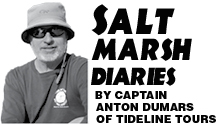Care and Cautiousness at the Boat Landing
 I made my way to the southernmost dock of the Folly boat landing. This spot works best for prolonged parking. A commercial oyster boat occupied the dock half farthest from land. Low tide shrank the available dock space, giving me just enough room to slip inshore of the oyster boat and tie off. The aluminum cleats on the floating dock sat in all stages of completeness. Those offered to me had lost their horns and now resembled closed chocks. It was early afternoon on a fall Friday.
I made my way to the southernmost dock of the Folly boat landing. This spot works best for prolonged parking. A commercial oyster boat occupied the dock half farthest from land. Low tide shrank the available dock space, giving me just enough room to slip inshore of the oyster boat and tie off. The aluminum cleats on the floating dock sat in all stages of completeness. Those offered to me had lost their horns and now resembled closed chocks. It was early afternoon on a fall Friday.
I unloaded my bicycle and started peddling home. Today was boat maintenance day. Approximately every 100 engine hours, I change the motor oil and lower unit (gear case) oil. During the busy season, scheduling maintenance means potentially loosing a charter, but not conducting regular maintenance may mean loosing a season. Since the boat and the landing and the trailer, tools, and parts were all in different places, I’d worked out a one-person scheme to get them all in the same place. I bicycled to the marina, and then drove the boat, with bicycle inside, to the boat landing for haul-out. After securing the boat at the dock, I rode home, ditched the bike, and drove truck and boat trailer back to landing. Finally, I hauled the boat out onto the trailer.
Once out of the water, I backed the rig into an isolated space at the far corner of the parking lot. A mix of boats and boaters cycled through the landing. Mostly, older men, in pairs or trios, made their way to or from time spent fishing. Others came and went in small center console charter boats, beat-up crab boats, and various other work boats. Newer trucks usually towed newer boats, older trucks with older boats.
Besides just the utility of launching and retrieving a boat, landings offer an entertainment element: awkward trailer backing, dead batteries, forgetting to put the plug in, drunkenness, dogs running wild, sunken vehicles… the list goes on. To avoid creating a spectacle, the experienced boater operates about a boat landing with a sense of caution.
I pulled on my light blue nitrile gloves and placed the waste oil pan just behind the outboard. The crankcase drain plug is situated in a blind cavity at the base of the cowling. Once pulled, all five quarts of hot oil drain uncontrollably. To catch this flow, I’d fashioned a large funnel, bungee cords, duct tape, and a PVC pipe into an oil-catching conduit. As hoped, all the oil drained into the pan, avoiding an “Anton Valdez” spill in the parking lot. Once drained, I secured the drain plug back into the threaded hole hidden in the cavity. I replaced the oil filter, and then filled the crankcase with fresh oil.
Next came draining the lower unit oil. This oil, with a viscosity similar to thin honey, drains slower than the motor oil. An outboard lower unit has two small plugs to access the oil: one at the top and one at the bottom. With the drain pan in position, I unscrewed the bottom plug with a large slotted screwdriver. Next I unscrewed the top plug, creating a vent to allow air in as the oil drained out. If the old oil appears milky, salt water has found it’s way into the gear case. Once detected, the lower unit must be repaired before further use to avoid catastrophic damage.
After all the gear oil drained, I meticulously cleaned the plug’s mating surfaces. One tiny bit of debris can allow water to get in where it shouldn’t. Next, I pumped the gear oil into the bottom plug until it vented out of the top plug. Once full, I screwed the plugs back into place.
I watched as two Game Wardens stepped from their four-wheel-drive truck and walk to the landing. Crisp olive green uniforms complement the holstered Glock side arms and marine-style haircuts. Time to check fishing licenses.
Now finished with my work, I re-launched the boat. As I backed down the steep ramp, my front tires began to slide on spartina wrack and pluffmuded pavement. The two officers watched as I continued to slide uncontrollably, gaining a bit of speed. Just as the boat hit the water, my tires gained traction enough to stop my descent. I launched the boat, then motored back to the marina, thankful for not becoming another boat landing spectacle.
Anton DuMars, owner of Tideline Tours, is a coastal geologist who turns a wrench when necessary. Visit tidelinetours.com and sign up to receive limited ½ off charter offers. Tideline Tours located at 103 East Cooper on Folly Beach. Visit www.tidelinetours.com or email saltmarshadventure@gmail.com

